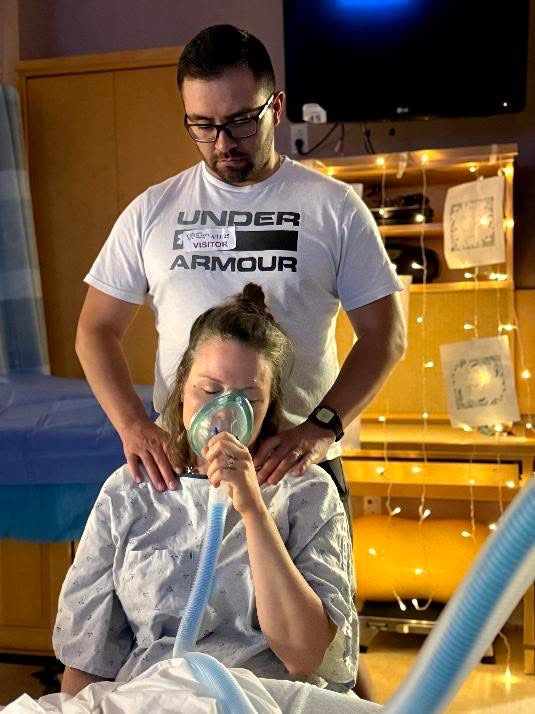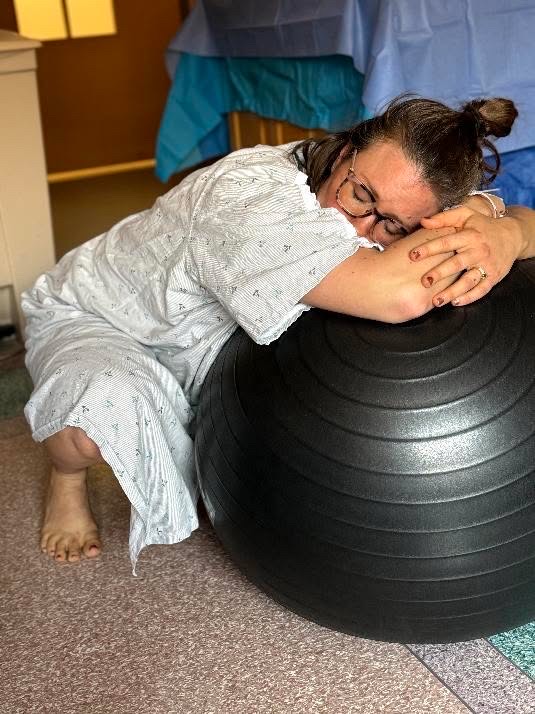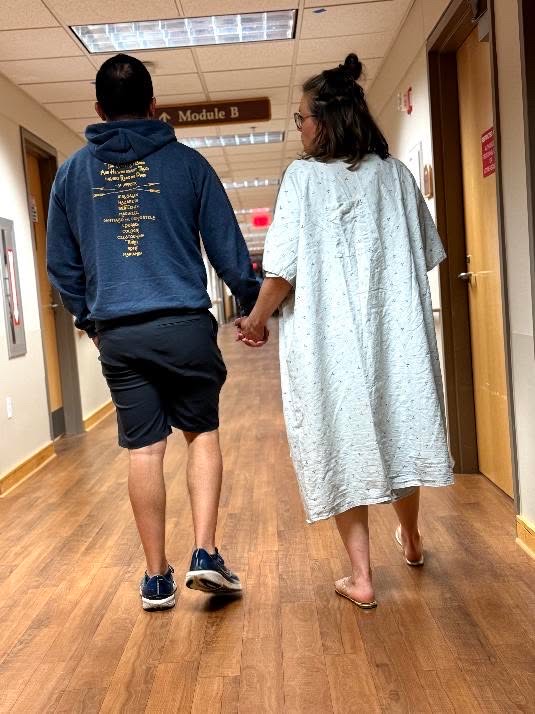In Part I, I wrote about how the birth of my fourth child was unnecessarily traumatic. Unfortunately, I know I’m far from the only one to have this sort of negative hospital birth experience. I also knew that a homebirth wasn’t for me. With the birth of my fifth child, here’s what I did differently to have a positive, unmedicated hospital birth story.
We hired a doula
The single most important thing we did to have a positive hospital birth experience was hire a doula. I interviewed my doula (Grayce) virtually, and then signed a contract around twenty weeks pregnant. Starting early in the third trimester, she checked in with me regularly via text, asking how my appointments were going and what questions I had. In return, she offered food for thought, and resources for conversations with my OB/GYN.
The single most important thing we did to have a positive hospital birth experience was hire a doula.
Around 35 weeks, she came to my house for a prenatal appointment with my husband James and I, where we reviewed the things about my previous labor that we sought to avoid this time around, and the role we hoped she’d play in making that happen.
I spoke to the nurse manager at the hospital
Around 37 weeks, I also spoke to the nurse manager on the Labor & Delivery unit at the hospital. I shared my previous experience with her and invited her input on how things could be different this next time. To her credit, she apologized for the poor care we’d received (which wasn’t on her watch) and she promised to notify her dayshift and nightshift assistant managers to be on the lookout for us when we came in for delivery. She additionally encouraged us to call the hospital when we were on the way in, to specifically request a nurse passionate about unmedicated birth.
I spoke with my OB/GYN and she spoke with her colleagues
Lastly, I clarified several things with my OB/GYN during my late third-trimester appointments, including my ability to decline the ultrasound routinely performed on admission to “make sure baby is head down” (a modern necessity, since doctors skilled in assisting with breech birth are unfortunately now so rare). (NB: my OB/GYN told me she’d found that hospital staff respond better to the word “decline” than “refuse.”)
During my previous birth, I’d tried to decline the ultrasound because I’d had a cervical check in my doctor’s office during my routine 40 week appointment, just half an hour before. It was at that appointment that my doctor had sent us to the hospital, because she’d discovered that I was already 6cm dilated, which meant active labor was beginning! Ultrasounds were expensive, I knew, and the baby had been confirmed head down literally 30 minutes prior to admission. Still, the resident was insistent and persistent that I needed the ultrasound, and eventually, I’d reluctantly agreed. For this next birth, refusing the ultrasound upon admission was important to me, because it had been the first point in the breakdown of trust during my previous birth.
For this next birth, refusing the ultrasound upon admission was important to me, because it had been the first point in the breakdown of trust during my previous birth.
Before my fifth labor, my OB/GYN asserted that I had every right to politely, calmly decline the admission ultrasound. Furthermore, beyond giving me a pep talk, she said she’d speak to her colleagues who would be on call the week I was due, to ensure my preferences would be respected.
Go time
My husband called ahead as we drove to the hospital early in the morning when I was in labor at forty weeks and five days pregnant. While whoever answered the phone initially insisted vaguely that “all” the nurses were skilled in supporting unmedicated birth, her tone changed when my husband told her that the nurse manager had specifically asked us to call and make this request. From the time we walked through the doors, every single staff member was respectful of my wishes.
From the time we walked through the doors, every single staff member was respectful of my wishes.
This included my successful refusal of the not-so-obligatory ultrasound (in lieu of this, the on-call OB/GYN asked to perform a cervical check to ensure for herself that the baby was head down, to which I agreed). The OB/GYN also accepted my preference for intermittent monitoring, which is the evidence-based form of monitoring for low-risk women, after an initial twenty minute nonstress test. (I would have had a NST anyway if I had made it to my forty week appointment originally scheduled for that afternoon.)
Ironically, if ever there was a time when interventions to “help things along” were arguably (possibly) appropriate, it was this labor and birth experience. I went in earlier than I would have otherwise (my contractions were consistently five minutes apart), because I wanted to be sure to get a dose of antibiotics at least four hours before my baby was born due to my positive Group B Strep (GBS) status. In part for this reason and, I believe, in larger part because my intelligent body remembered how things had gone the last time, my contractions abruptly stopped shortly after we arrived.
Stalled labor
Even though I was five centimeters dilated and 80% effaced on admission, my contractions did not meaningfully restart for eleven hours. During that time, after an initial rest period, my husband and doula helped me with massage, positioning techniques, walking around, and anything else we could think of to kickstart contractions. Their soothing, steady reassurance that we were in no rush, that everything would happen in good time, helped keep my exasperation at bay.
During that time, after an initial rest period, my husband and doula helped me with massage, positioning techniques, walking around, and anything else we could think of to kickstart contractions. Their soothing, steady reassurance that we were in no rush, that everything would happen in good time, helped keep my exasperation at bay.
Grayce also helped set the mood by diffusing essential oils and putting up twinkly lights and the birth affirmation papers I’d used with each birth. I truly believe the environment she helped facilitate unconsciously coached all who entered the room on how to approach me and my labor.
For their part, my nurse and the doctors that periodically checked on me never once mentioned breaking my water, starting Pitocin, or any other medical intervention. Instead, they let me be, only coming in to check my vital signs or listen to the baby’s heartbeat.
As I was beginning to wrap my head around the idea (my own) of going home and returning another time, my nurse was the one to suggest I try pumping to restart labor. Though it inexplicably took almost two hours to get the breastpump and correctly sized flanges, less than ten minutes after the nurse got everything set up, I had my first strong, painful, crampy contraction. Five minutes later, I had another. Then another.
Labor had officially, blessedly restarted.
Labor progress
After that, labor progressed quite smoothly. I turned on the “chill and relaxing praylist” on the Hallow app, and the sounds of it filled the dimly lit room as the afternoon waned and evening came on. A few hours later, I was eight centimeters and 90% effaced, contracting every four to five minutes. With my previous birth, my contractions had never been closer than four minutes apart, so I knew I wasn’t necessarily waiting for them to get closer together. At that point, I felt elated, jubilant. I could do it. I was doing it.
I was so close to meeting our baby.
…but not as close as I’d hoped.
By 8pm, I was complete, 10 centimeters dilated. I figured that, as with my previous three unmedicated births, my body would begin involuntarily pushing. I might have a short period of ‘laboring down,’ as I’d had once before, as my body geared up for the finale.
But that’s not what happened.
When I started making low-throated, grunty, push-y sounds while sitting on the toilet a short time after that cervical check, my doula called the nurse and staff into the room for showtime. But as soon as everyone was ready, my uterus developed performance anxiety. All instinct to push left me. For an hour, the staff waited quietly in the dark off to the side of the room, out of my direct line of sight. With each contraction, my husband held counterpressure on my lower back and hips, Grayce wiped my forehead with cold cloths, and I held the nitrous oxide mask to my face for relief from the feeling of needing to run away from the pain. But I was no longer ready to push.
Eventually, they all left without a word. There was still no pressure, no talk of doing anything differently. We were all trusting my body, and my body was still feeling unsafe in remembrance of how things had turned out the last time I’d been this physically and emotionally vulnerable.
Images from a peaceful hospital birth experience
“I truly believe the environment [Grayce, my doula] helped facilitate unconsciously coached all who entered the room on how to approach me and my labor.”
A supported birth
The difference was that this time, I was safe. My baby and I were being well cared for, supported by those around us. My memories of the past, and the protective physical reactions to those memories, did not match my present reality. It just took some time for my body to accept this.
This part of my labor was undeniably the most difficult, and yet, in a mysterious way, the most important for myself and for the hospital staff. I was completely unable to “perform” for anyone else in those moments. Those around me, from my husband and doula to the hospital staff, simply had to wait with and for me. While my body was not doing what I wanted it to– and I very much wanted it to begin pushing out my baby–everyone had to be content with imperfection. I was not a machine, and, in utter contrast to so many laboring women’s experiences, in that hospital room that night, that fact was completely accepted.
This part of my labor was undeniably the most difficult, and yet, in a mysterious way, the most important for myself and for the hospital staff. I was completely unable to “perform” for anyone else in those moments. Those around me, from my husband and doula to the hospital staff, simply had to wait with and for me.
Nearly two and a half hours after I was complete, Grayce asked the nurse to get an inflatable stool that mimicked a toilet, with a hollow center. When the nurse returned with the stool, Grayce put it between the bed and bathroom, with pads down on the floor underneath it. I sat there for two contractions. With the second contraction, my husband says he shifted the pressure he was holding on my low back, and my baby came out with great guttural sounds and one powerful push, straight into my and my doula’s hands. It was 10:29 pm.
All was calm, all was bright
The nurse happened to have come into the room to check the baby’s heart tones, and the OB/GYN was right behind her. As they realized what was happening, they stepped close to me, but remained to the side.The doctor had one glove on as I pushed, so she stood by as Cecilia Caeli Williams entered the world. Instantaneously, Grayce helped me scoop Cecilia up onto my chest. She then switched places with my nurse, who rubbed Cecilia’s back with a blanket. A few minutes later, they helped me onto the bed to have my bleeding checked and placenta assessed. To use the words of the old Christmas hymn, all was calm and, even in that dimly lit room, all was bright.
In the weeks following my fourth birth, I became progressively more upset about my labor and birth experience. After this fifth birth, the opposite occurred. As time has passed, I’ve become increasingly satisfied, grateful. It was no fairytale, but it was a profound experience of being accepted exactly as I was. That’s a positive hospital birth story worth sharing.











Way to go, Anne Marie!! What a great story, thank you for sharing!
Cecilia “of Heaven”: a very beautiful name.
My wife and I are expecting our second child, and we’re hoping to have a hospital success. Medicaid doesn’t afford us many options for unmedicated-friendly OBs, but we’re hoping self-advocacy and help from a charity-funded doula can make the difference. Your story gives us some hope.